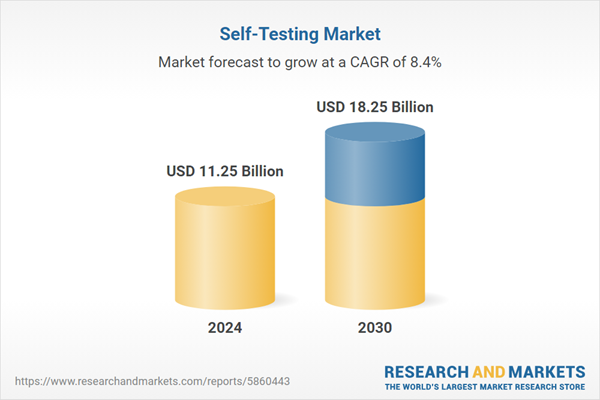Speak directly to the analyst to clarify any post sales queries you may have.
10% Free customizationThis report comes with 10% free customization, enabling you to add data that meets your specific business needs.
Key Market Drivers
Aging Population and Rise in Chronic Conditions
The expanding elderly population and growing incidence of chronic illnesses are major factors driving the global self-testing market. The United Nations projects the number of people aged 65 and older will reach 1.6 billion by 2050, doubling from 761 million in 2021. This demographic shift brings greater healthcare needs, especially for ongoing monitoring of conditions such as diabetes, cardiovascular diseases, and hypertension. Self-testing solutions enable elderly individuals to manage these health conditions independently and effectively, reducing their dependency on clinical settings.Chronic disease trends are also evident in younger populations, influenced by sedentary lifestyles, poor diets, and increasing stress levels. This has led to a broader demand for at-home diagnostic tools to monitor parameters like blood pressure, cholesterol, and glucose levels. Additionally, over 73% of noncommunicable disease-related deaths occur in low- and middle-income countries, highlighting a global public health need for accessible and scalable diagnostic tools. The shift toward proactive, at-home monitoring is reinforcing long-term demand for reliable self-testing products.
Key Market Challenges
Risk of Complications and Procedural Limitations
Despite the rising adoption of self-testing kits, procedural limitations and risks of misinterpretation remain key challenges. Users without proper medical guidance may misread results or delay seeking professional care, potentially exacerbating health conditions. Furthermore, the accuracy of some self-tests can vary depending on user compliance with instructions and the type of test administered. Regulatory oversight remains critical to ensure product reliability, but inconsistent regulatory standards across regions can lead to quality disparities in available self-testing options. These limitations can hinder trust in self-testing devices, particularly in lower-income regions or among less technologically adept populations. Addressing these concerns will be vital for continued market expansion and for ensuring that self-testing remains a safe and effective tool within broader healthcare systems.Key Market Trends
Integration of Advanced Technologies and Innovations
Technological advancements are rapidly reshaping the self-testing landscape, with innovation focused on improving accuracy, usability, and connectivity. Self-testing devices are increasingly incorporating digital readouts, smartphone integration, and cloud-based data storage, enabling users to track and share health metrics seamlessly. Artificial intelligence and machine learning are being explored to enhance test interpretation, particularly in complex areas like allergy testing or cancer screening. Additionally, portable biosensors, wearable health monitors, and app-based testing platforms are gaining traction, particularly among younger, tech-savvy users. These innovations are enhancing consumer confidence and encouraging routine health monitoring. As digital health ecosystems expand globally, the integration of smart self-testing tools into personal health records and telemedicine platforms is becoming a defining trend in the market.Key Market Players
- Geratherm Medical AG
- Cardinal Health
- OraSure Technologies, Inc
- bioLytical Laboratories Inc
- PRIMA Lab SA
- Becton, Dickinson and Company
- F. Hoffmann-La Roche Ltd
- Bionime Corporation
- Abbott
- Everlywell
Report Scope:
In this report, the Global Self-Testing Market has been segmented into the following categories, in addition to the industry trends which have also been detailed below:Self-Testing Market, By Product:
- Kits
- Devices
- Strips
Self-Testing Market, By Sample:
- Blood
- Urine
- Stool
- Others
Self-Testing Market, By Application:
- Blood Pressure Test
- Diabetes and Glucose Tests
- Cholesterol and Triglycerides Tests
- Pregnancy Test
- STD / STI Test
- Urinary Tract Infection Test
- Cancer Test
- Celiac Disease Test
- Thyroid Test
- Transaminase Test
- Anemia Test
- Allergy Test
- Others
Self-Testing Market, By Distribution Channel:
- Online
- Offline
Self-Testing Market, By Usage:
- Disposable
- Reusable
Self-Testing Market, By Region:
- North America
- United States
- Canada
- Mexico
- Europe
- France
- United Kingdom
- Italy
- Germany
- Spain
- Asia-Pacific
- China
- India
- Japan
- Australia
- South Korea
- South America
- Brazil
- Argentina
- Colombia
- Middle East & Africa
- South Africa
- Saudi Arabia
- UAE
Competitive Landscape
Company Profiles: Detailed analysis of the major companies present in the Global Self-Testing Market.Available Customizations:
With the given market data, the publisher offers customizations according to a company's specific needs. The following customization options are available for the report.Company Information
- Detailed analysis and profiling of additional market players (up to five).
This product will be delivered within 1-3 business days.
Table of Contents
Companies Mentioned
- Geratherm Medical AG
- Cardinal Health
- OraSure Technologies, Inc
- bioLytical Laboratories Inc
- PRIMA Lab SA
- Becton, Dickinson and Company
- F. Hoffmann-La Roche Ltd
- Bionime Corporation
- Abbott
- Everlywell
Table Information
| Report Attribute | Details |
|---|---|
| No. of Pages | 180 |
| Published | May 2025 |
| Forecast Period | 2024 - 2030 |
| Estimated Market Value ( USD | $ 11.25 Billion |
| Forecasted Market Value ( USD | $ 18.25 Billion |
| Compound Annual Growth Rate | 8.3% |
| Regions Covered | Global |
| No. of Companies Mentioned | 10 |









